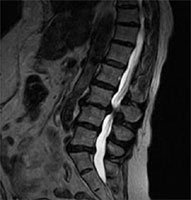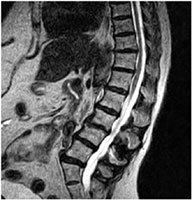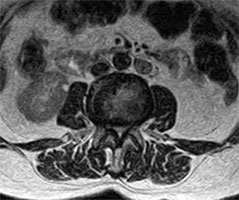Interspinous distraction device yields better results in discs with more height
At 2-year follow-up, 42% of patients with discs less than 5 mm high showed clinical improvement.

The quality of the clinical outcome that patients with lumbar spinal stenosis can expect 2 years after surgical treatment with an interspinous distraction device is associated with their preoperative disc height, a recently reported study found.
“A larger proportion of patients with bigger preoperative disc height — and we are talking about 5 mm here as a cut-off — had a better clinical outcome,” Mukta Vadhva, MS, said.
During the British Orthopaedic Association 2009 Congress in Manchester, England, she presented findings from a study of the X-Stop device (Medtronic) that researchers in Aberdeen, Scotland, conducted.
“The aim was to assess the effectiveness based on relation to the preoperative disc height,” Vadhva explained.
She noted during the discussion period that the concept merited further study.
|
Image: Trace R, Orthopedics Today |
Positional MRIs
Vadhva and colleagues used erect positional MRI scans to measure preoperative disc height in 45 patients diagnosed with lumbar spinal stenosis, comparing the measurements to postoperative clinical improvements at 6 months and 2 years after surgical implantation of the X-Stop device.
Investigators measured on MRI scans the height of the disc when patients were sitting and standing erect and when their spines were in neutral and flexion/extension. They averaged the measurements to determine the overall disc height, where 5 mm or less represented a short disc and any more than 5 mm represented a high disc.
To assess clinical improvements from the surgery, investigators used the Zurich Claudication Questionnaire (ZCQ).
Claudication relief
Based solely on the ZCQ results, 73% of the patients were clinically improved 2 years after they received the device.
Among those whose discs were characterized as high, 58% were clinically improved. Slightly less clinical improvement was seen in those with a short disc height, Vadhva said.
The difference in results between the two groups was not statistically significant, she noted.
A few audience members queried Vadhva about the findings during the paper’s discussion. One person asked about the flexion measurements on MRI in the series because he said it was an important factor usually associated with effectiveness. Although those measurements were available, Vadhva said they were not analyzed for this study.
|
|
|
|
|
Image: Images: Nandakumar A |
Another attendee wondered why greater disc height might be associated with better outcomes.
“We are not absolutely clear on that,” Vadhva said. She theorized the amount of distraction needed for the X-Stop implant to effectively relieve symptoms might simply have been easier to achieve in those with higher discs.
For more information:
- Mukta Vadhva, MS, is a clinical research fellow. She can be reached at the Positional MRI Centre, Woodend Hospital, Aberdeen AB15 6XS, Scotland; 44-1224-556373; e-mail: mvadhva@nhs.net. She has no direct financial interest in any products or companies mentioned in this article.
References:
- Nandakumar A, Clark N, Bilolikar N, et al. Two year clinical results of X-Stop interspinous decompression device in the management of symptomatic lumbar canal stenosis: Does the clinical outcome relate to the preoperative disc height? Presented at the British Orthopaedic Association Annual Congress 2009. Sept. 15-18, 2009. Manchester, England.
- Nandakumar A, Clark N, Bilolikar N, et al. Two year clinical results of X-Stop interspinous decompression device in the management of symptomatic lumbar canal stenosis. Spine J. 2008;8:121S-122S.





